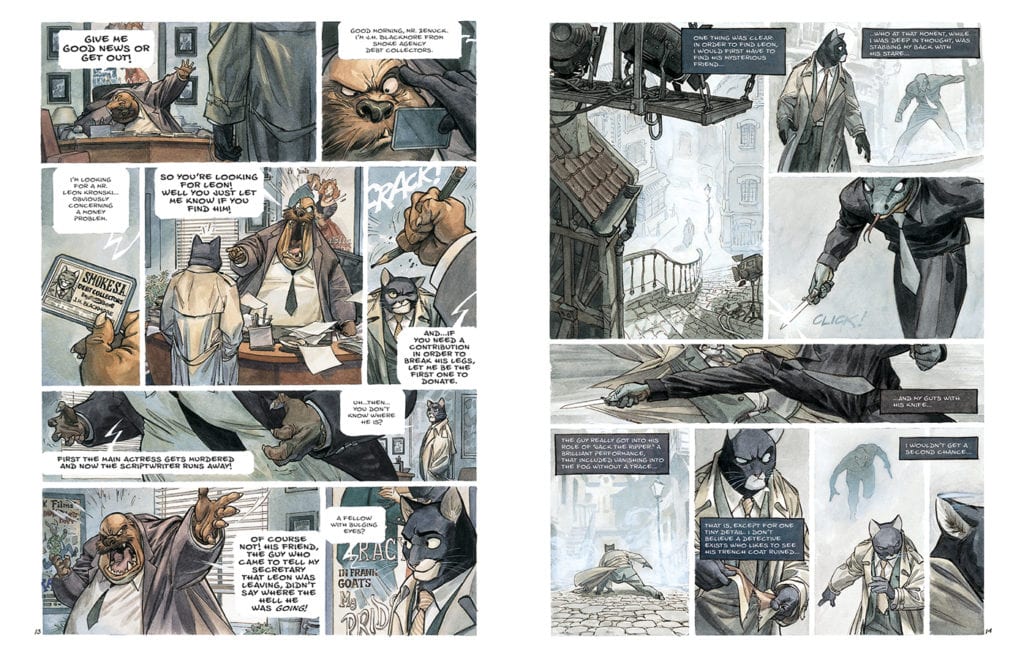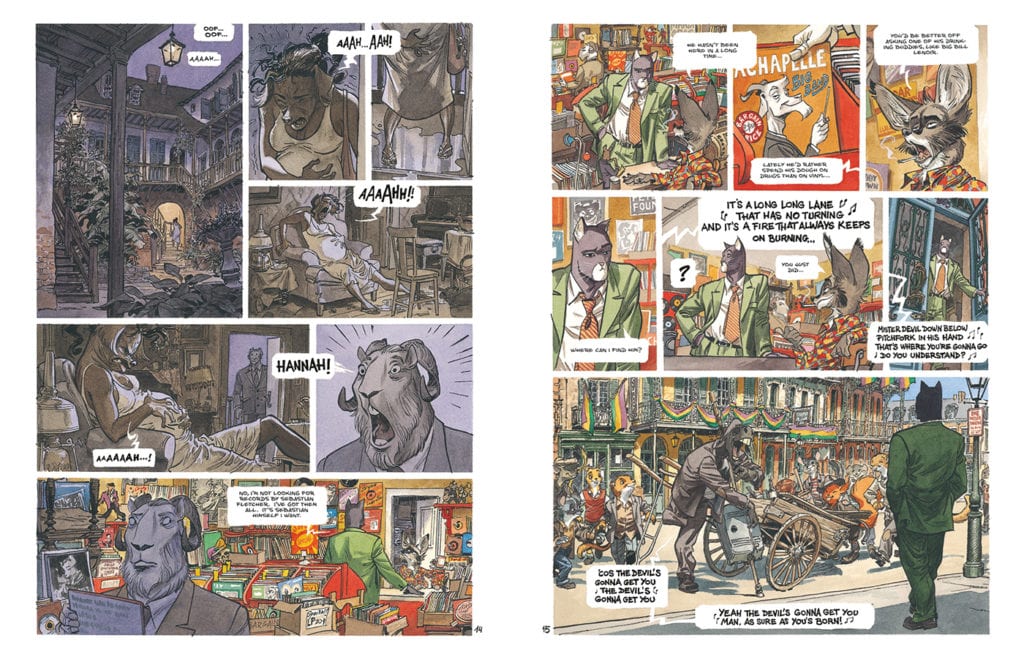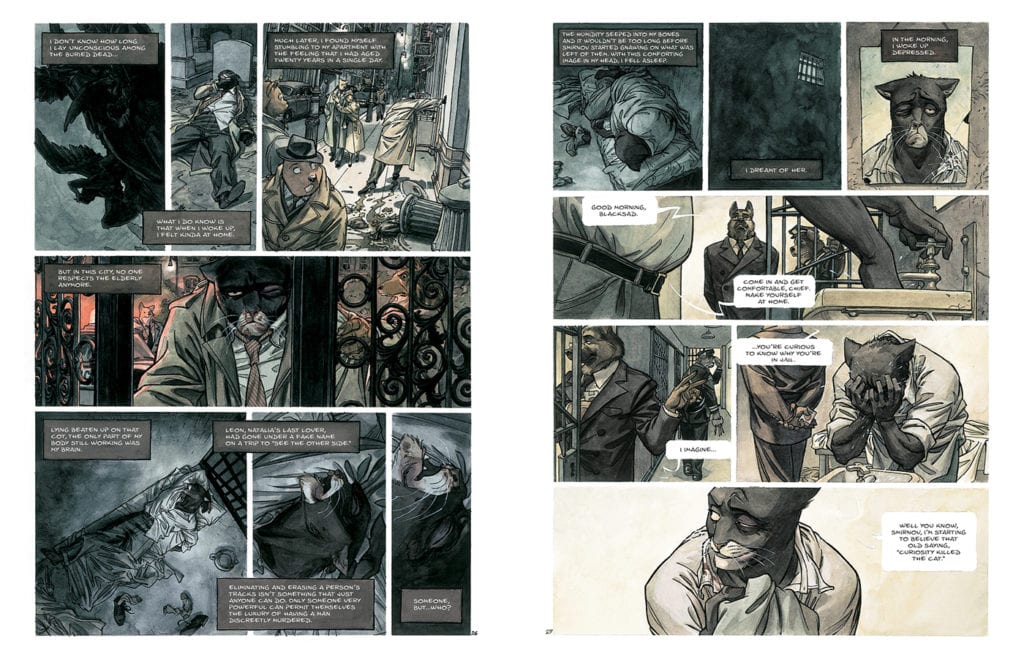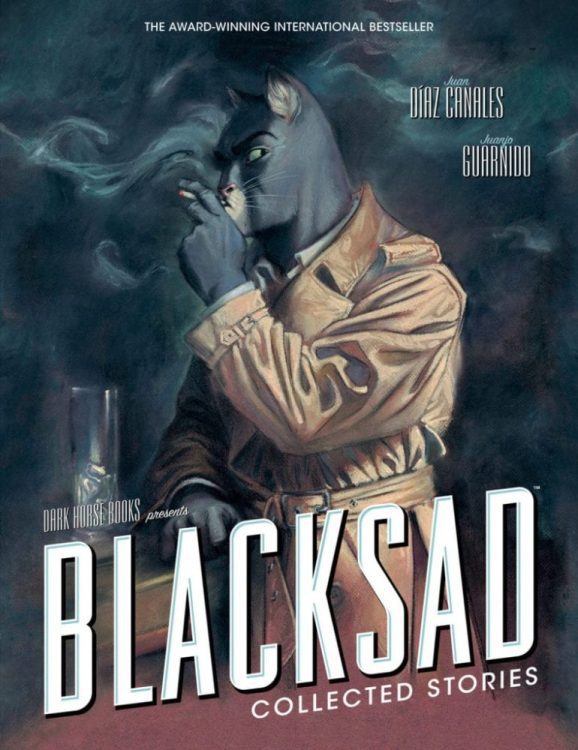Twenty years ago now, creators Juan Diaz Canales and Juanjo Guarnido, both storytellers in comics and animation, released the first installment of Blacksad to critical acclaim. The pulp neo-noir tales of feline detective John Blacksad have become a contemporary classic in the comics medium, and now they are all collected for the first time in Blacksad: The Collected Stories. This new paperback edition collects all the stories from the first Blacksad graphic novel collection, as well as “A Silent Hell,” “Amarillo,” along with additional sketches, short stories, and an introduction from industry legend Jim Steranko. If you’ve never gotten your hands on this beautiful and poetic pulp hit, this is now the best way to do it.
“Blacksad is constantly up to his ears in trouble. Sticking his nose into mystery after mystery, often getting involved with women almost as dangerous as the criminals he thwarts. Be it solving the murder of a famous actress or keeping nuclear weapons out of terrorist hands, Blacksad’s grim work often provides a mirror for real-world conflict and human issues, never turning a blind eye to racism, political tensions, or brutally sudden violence.”
Writing & Plot
Blacksad has already received mountains of praise for its creative, modern pastiche noir storytelling direction, and I’m going to be upfront about just adding onto the pile. If Howard Hawks and Will Eisner were to meet in the 2010’s, read up on issues of class and race, then decide to go watch Zootopia together, then I imagine Blacksad would be the result. Fortunately, somehow series writer Juan Diaz Canales is enough of a genius to put all this together in an immensely effective collection of short stories. Detective John Blacksad is obviously inspired by Golden Age noir icons like Humphrey Bogart and Robert Mitchum, but he’s not in any way derivative. Aside from obviously being a cat and living in a world full of anthropomorphic animals, Blacksad is set apart from his inspirations by his affiliations, his code of honor, and distinct motivations that are caused by these two elements.
Being a comic, Blacksad is allowed to be more obviously political and mature than most of its classic noir inspirations. This comes out as each story tackles blatant sexism in the form of patriarchal power, racism in the form of small-scale fascism, fear and hate-mongering during the Red Scare, and classism through nuanced examples. Canales digs in at complex issues with a careful hand that is still entirely in keeping with noir conventions. Blacksad is also more morally principled than many pulp protagonists. He’s constantly befriending or allying with the struggling underdogs he uncovers in his cases, many of which are victimized by corrupt power structures. He does well with the ladies, but he isn’t a womanizer. As much history as noir has within the comics medium, John Blacksad may be the most engaging protagonist to read out of them all. The anthropomorphization of the characters in Blacksad is the creative touch that separates these stories from the rest of the noir-comics world, and as absurd as it may seem from the outset, it’s almost unnoticeable when you sit down to actually read it. Each character embodies whatever animal they’re drawn as. A principled police commissioner is a German Shepard, a good-humored but shady agent is a hyena, a fool who witlessly repeats whatever he hears is a parrot, etc. Much of what makes this work so well is the art direction, but we’ll get to that later. This is a writing choice that works almost inexplicably well that sets and makes Blacksad an icon among noir comics.
It would be remiss to talk about the writing in Blacksad without acknowledging the team that worked on the Spanish-to-English translation of these stories. Anthya Flores, Patricia Rivera Diana Schitz, Katie LaBarbera and, believe it or not, the Neal Adams. Contrary to popular belief, translation is not just mindlessly repeating whatever the original said in their original language over to English. Truth is, languages often do not cleanly translate into one another, so it’s up to localization experts to take the original text and alter it in ways that are easy to understand and still convey the author’s intended meaning. Canales’s poetic passages and brilliant pulp dialogue are translated beautifully into this English collection, with the highlight truly being Adams’s work on “Amarillo.” While admittedly some of the early chapters do come off a tad clunky, it never detracts from the experience and disappears entirely from the text the further into the book you get. Blacksad is a beautifully written comic experience through and through.
Art Direction
I might as well say this upfront: Blacksad is one of the most impeccably drawn pieces of graphic literature there is. Juanjo Guarnido‘s work is that of a practiced master. His time as an animator for Disney on films such as Tarzan and Atlantis makes itself present on each and every page of this series, as the naturalistic animation of each and every character that strolls across the page is near-unmatched in this medium. The film noir and time period influences appear in the shifting aesthetics and landscapes from story to story. The first few Blacksad chapters are dominated by the smog-laden streets of Chicago, which cast a beige pallor on every panel. This also sells the post-war black & white era of film that these stories draw so much influence from. The later stories like “Silent Hell” and “Amarillo” are more colorful affairs in different parts of the country, and their colors and aesthetics are more akin to a 50’s globetrotting film, filmed entirely in wonderful technicolor. Guarnido’s penciled details of each story are incredible, as well, from the architectural details of each city, landscape geography, and especially his ability to draw large crowds. Every page, regardless if it’s just John Blacksad himself or a massive cast in view, explodes with vivid life. There’s an effortless grace to the work here, one that, as Jim Steranko notes in the introduction, is so good it’s impossible to see how much work goes into it. Remember that “inexplicable” quality to the anthropomorphic characters I mentioned earlier? Well, Steranko also comments in the introduction that this quality rests on the characters not being animals who are acting like people, but on the fact that they are “people resembling animals.” The artistic care taken with every character in the way their faces light up, become downcast, or grow angular when under threat or anger, makes Blacksad & Co. some of the most well-realized people in any comic. Guarnido takes the written direction of Canales and weaves a visual story that is a stirring visual tribute to a classic genre, while still glistening with gorgeous originality.
Juan Diaz Canales and Juanjo Guarnido’s Blacksad is a modern classic in the comic and graphic novel medium. It is a brilliant pastiche work dedicated to film noir and pulp comics, while also being an incredibly unique work on its own. Delightfully funny and heartbreaking all at once, and being as close to visually perfect as a comic can be, the stories of John Blacksad, P.I. are essential on any collector’s shelf. This new paperback of the collected stories from Dark Horse Comics are the easiest and most affordable way to own these works (although seeing Guarnido’s work in an oversized hardcover would be incredible). Order this must-own volume from your local comic shop when it releases on July 15th!


